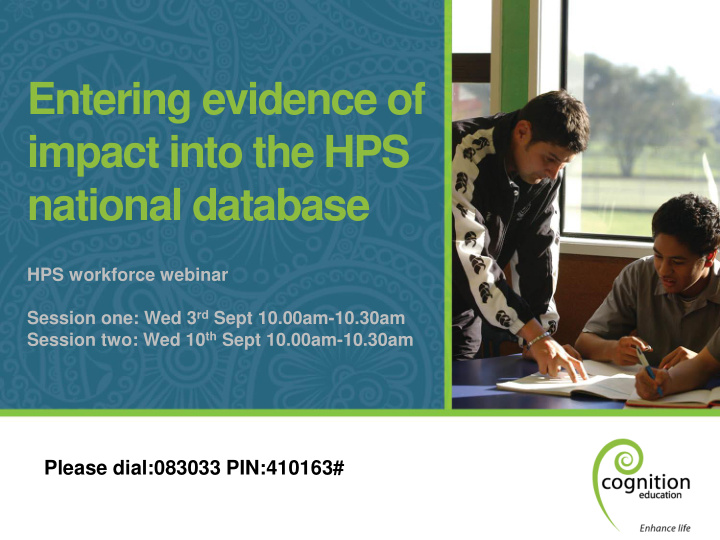



Entering evidence of impact into the HPS national database HPS workforce webinar Session one: Wed 3 rd Sept 10.00am-10.30am Session two: Wed 10 th Sept 10.00am-10.30am Please dial:083033 PIN:410163#
School health and wellbeing self- review tool 1. practice making judgements, gathering data and entering this into the new database 2. prepare for conversations with your school communities 3. review your current delivery of HPS service 4. plan your individual and team targets for 2015
Tools - School profile - School health and wellbeing self- review tool - HPS brochure - HPS national presentation - HPS key messages - School health and wellbeing self- review tool - Planning template Suggested process
Evidence of HPS impact Since 2011, the MOH has asked facilitators to consider the degree • that HPS processes are embedded in schools practices for each school they support when completing the HPS national database. These levels of integration are: Engage • Implement • Embed • In 2013, a ‘level of integration’ rubric was developed for the HPS • sector to provide some consistency in reporting.
Evidence of impact tools • Following sector and Ministry of Health feedback, this tool has been adapted to provide evidence of impact/shift the schools have made in key health, wellbeing and education related dimensions. • The measurement used is "effect size". • Effect size measures the progress by comparing results in key dimensions across two points in time.
The scale
Effect size • This new tool will enable us to measure the effect size for each school/ECE, each HPS provider and of HPS nationally. • This is a really useful measure because it defines what meaningful progress looks like and demonstrates the value added to school communities.
How does the School Health and Wellbeing Review Tool connect to the Planning Template…and ultimately add value to schools?
Areas of responsibility for boards and school leaders
Evidence of impact tools The School Health and Wellbeing Review Tool deliberately aligns with schools areas of responsibility. We can now clearly provide focused support and evidence so schools can see how HPS (and their health/wellbeing inquiries) can add value to them!
The database – you need to enter • School name • HPS facilitator name • Health/wellbeing priorities (note simplified list) • Time 1 (November 2013) and Time 2 (November 2014) for each dimension Note – the first page of the updated planning template contains all the information needed for data entry Just use drop down boxes – no typing please!
Tab 2a) Data Entry-Schools Note – data just an example
Tab 2a) Data Entry-Schools
Tab 1b) DHB graphs = data for your service A bar graphs showing the overall effect size of each dimension across • all schools (and your service overall) A bar graph showing average Time 1 and Time 2 of each dimension • across all schools A bar graph showing schools in your region receiving the HPS service • compared to all schools in your region (by decile) A bar graph showing the percentage of Maori and Pasifika students in • schools in your region receiving the HPS service A table of the percentage of schools in your region that have prioritised • government priorities Updated HPS snapshot (nationally and for your region) Feedback on planning templates
Note: Data just an example
Note: Data just an example
Tab 1a) Individual school graphs = Data to give back to the school Note: Data just an example Drop down box!
What do the numbers mean? • An effect size of: • d=0.2 would be small • d=0.5 would be medium • d=0.8 would be large
Options: Meet with each school your region is working with to decide on the • judgments for Time 1 and Time 2, celebrate the shifts and decide on the next priority. Emailing the tool out to your schools, then meet with each school you are • working with to decide on the judgments for Time 1 and Time 2, celebrate the shifts and decide on the next priority. Emailing the tool to your schools, then meet with the school to share the • judgements the facilitator had made in relation to Time 1. The facilitator, together with the school, then decides on the judgments for Time 2, celebrate the shifts and decide on the next priority. Emailing the tool to your schools, then meet with the school to share the • judgements the facilitator had made in relation to Time 2. The facilitator, together with the school then decides on the judgments for Time 1, celebrate the shifts and decide on the next priority. •
The bottom line Whatever you choose to do, by November 2014: each service will need to enter Time 1 and Time 2 points for each of their schools into the national database judgements would have been made in collaboration with schools
Process and timeline Date Process July-October Local training around using the evidence of impact tools 3 rd and 10 th September Webinar around entering evidence of impact into the HPS national database Now (ongoing) HPS workforce uses the School Health and Wellbeing Review Tool to make judgements in collaboration with schools to obtain two time points in each dimension, for each school community (see options that follow) This can be recorded in the updated planning template. Database will available to all facilitators this week so you can give your schools their overall effect size and graphs straight away 14 th November One person to collate and completed database and send to tireland- smith@cognition.co.nz HPS national leadership team will request 2 completed planning templates from each facilitator for moderation and feedback (randomly selected from the schools entered into the database). 21 st November HPS providers to send requested planning templates to HPS national leadership team 19 th December HPS managers sent: - Updated HPS snapshot - Planning template feedback
Recommend
More recommend